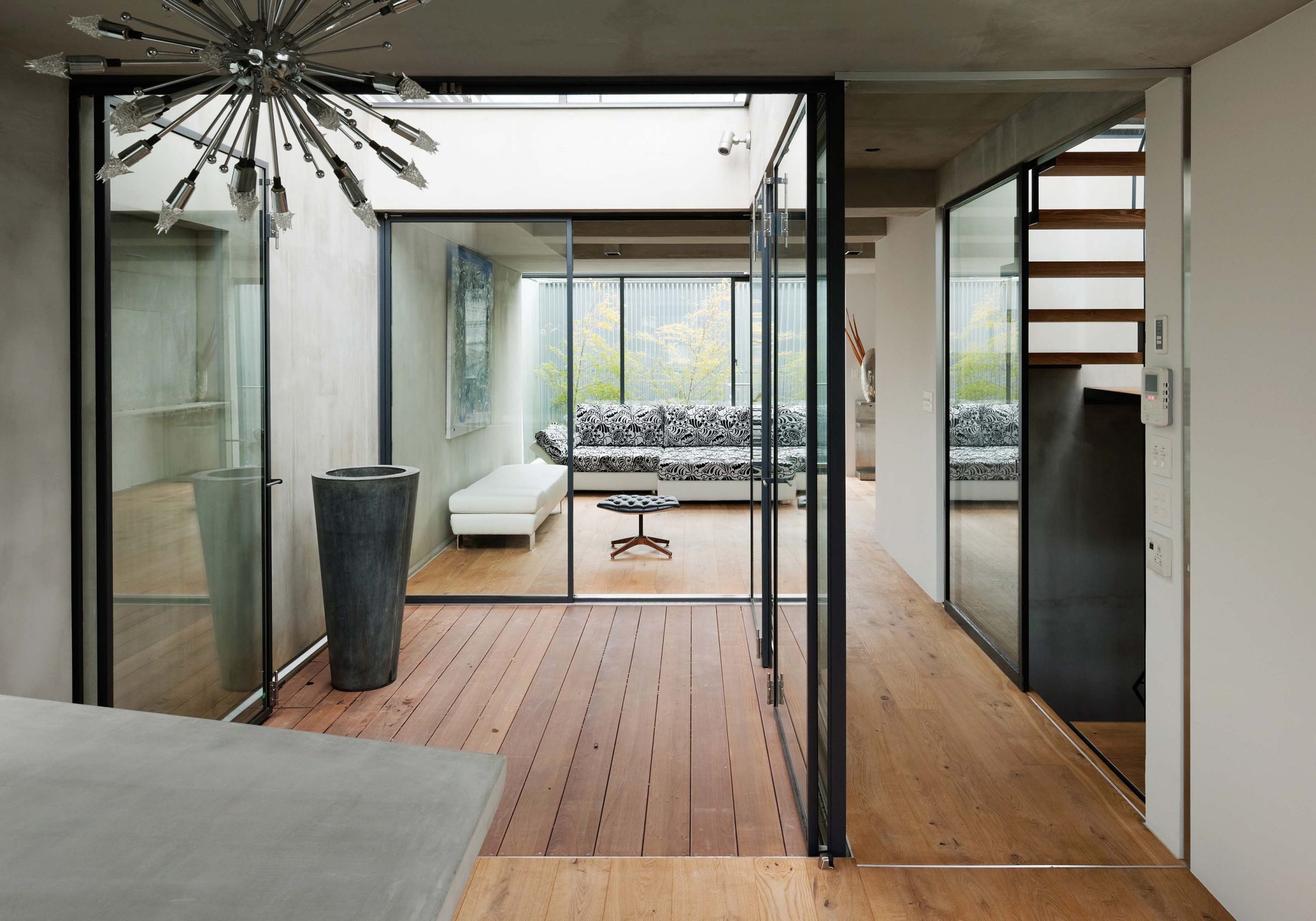Skycourt House
Site: 東京
Architect: 芦沢建築設立事務所
Project architect: 芦沢啓治 / 本条理恵
Structural engineer: ASA 鈴木啓
施工: 平成建設
Furniture: super robot
Window: supro
Photo: 太田拓実
東京屈指の商業エリアである六本木に至近でありながら閑静な住宅街に建つ、RC 造住宅のリノベーションである。要望としては、2 階建てを3 階にすること、屋上の活用、裏庭のプライバシーの確保、光にあふれた家、などがあった。またバブルの時代を反映した装飾的な外観も改装することになった。
リノベーションのプロジェクトは、既存の空間の特性や良さを読み解くことが重要である。躯体は大きく動かない。その躯体や壁をいかに活かすのか、現状の開口部や新たに設けられる穴からはどのような空間が生まれるのか。そうした意味において、クライアントが改装前に1 カ月のあいだ住んだことで、多くの情報を共有することができのは幸いであった。寝室の場所、キッチンやリビングの場所は、現地の光環境を考慮して、何度なく検討や変更のすえプランを決定した。キッチンとリビングの間に設けられた7㎡ほどの中庭は、彼らの第二のリビングである屋上の空間とつながり、光と風を引き込む。リビングと寝室は既存建築において余裕のあった容積を使って増床し、雑壁を取り払って大きな開口部を取り付けることで、都心部ではなかなか得にくい開放的な空間となった。
以前は室外機置き場であった屋上には屋根を取り付け、夜景を楽しめるオフィスとした。また、地下階にはゲストルームと小さなオフィスを新たに設えた。
Site: Tokyo
Architect: Keiji Ashizawa Design
Project architect: Keiji Ashizawa / Rie Honjo
Structural engineer: ASA Kei Suzuki
Furniture: super robot
Window: supro
Photo: Takumi Ota
Skycourt House is an ambitious renovation project that involved transforming a Japanese ‘bubble era’ house into a modern home connected to the city and the sunlight.
The house is located in a quiet residential area, a couple of blocks away from Tokyo’s business district. The original house plan was a dated two-storey house with cramped bedrooms, small windows and no indoor to outdoor traffic flow. The clients, a working couple with two children, wanted to maximise the living space, create a backyard with privacy and develop a structure flooded with light. As the original house was part of a set of twin houses, the clients also wanted to decorate the facade in order to distinguish it from its sibling. These requirements demanded bold renovations.
Remodelling in Japan is a relatively recent phenomenon. The average life-span of a building is less than 20 years, even less for central Tokyo. Building authorities are very reluctant to allow any alterations in structure (in part due to Japan’s earthquake standards) and are often only convinced after extensive negotiations and a complete re-analysis of the structure. Every successful renovation project requires the clients and architect to first recognise the positive characteristics of the existing space. In this case, it was helpful that the clients lived in the old structure for one month to add their real-life experiences to the design process.
Achieving the clients’ goals within the constraints of the building required a number of key changes: A new tent structure was placed on the top of the building thereby creating a new third-storey with an outside deck. Light was added in abundance by opening the south of the house and punching a courtyard out of the roof. To further capitalise on these changes, the order of the house was reversed so that the living, dining and kitchen were shifted to the upper floors thereby giving those areas access to even more light. A serene family area was created on the first floor by placing the bedrooms and family bathroom on the first floor and connecting the master bedroom to a Japanese style garden. The privacy of the bedrooms and garden was further ensured by erecting a two-storey louvre fence on the southern border. A quiet office and guest room were installed in the basement.
One of the key features of Skycourt House is the melding of indoor and outdoor spaces. On the second floor, the new internal courtyard serves as a separator between the kitchen and living room while ensuring visual connection from that floor to the roof-top terrace. Similarly, the lounge on the third floor connects to the outdoor deck and opens to the view of Tokyo’s skyscrapers that dazzle at night. Another important feature of the project is the creation of unusual volume. The hole punched through the roof creates a heart-like space in the centre of the house that opens to the sky. The new top floor (where the air conditioning units used to be) was one of the few places where old space did not have to be recycled and, as a result, the angular roof cap is juxtaposed against the existing straight walls.
In Tokyo, where space is at a premium, clients may need to accept a more vertical way of living, spreading over three or sometimes four stories. At the same time, the challenge to create great architecture requires developing new ways to completely utilise vertical spaces. When you also add the restraints of a renovation project to these existing hurdles, both sides need to be innovative. In this case, this challenge merely ignited the fires of everyone involved resulting in the generation of passionate synergistic energy for the project.
After the completion of the renovation project, we had the chance to visit the home a number of times and were struck by how the alterations matched the clients' lifestyle even more than anyone could have imagined. The house was lovingly given a name: The ‘court’ that was created during the renovation bathes the home with soft light and allows its occupants to gaze at the ‘sky’. The answer to the clients’ demands, a light filled home where one can feel connected and yet away from the city, is the definition of Skycourt House.
